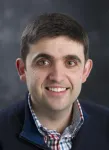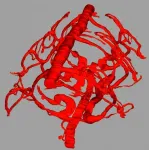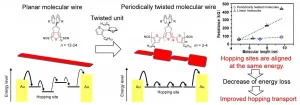Order and disorder in crystalline ice explained
A new theoretical model enlightens the structure and the electrical properties of pure and doped ice
2021-01-02
(Press-News.org) A fascinating substance with unique properties, ice has intrigued humans since time immemorial. Unlike most other materials, ice at very low temperature is not as ordered as it could be. A collaboration between the Scuola Internazionale Superiore di Studi Avanzati (SISSA), the Abdus Salam International Centre for Theoretical Physics (ICTP), the Institute of Physics Rosario (IFIR-UNR), with the support of the Istituto Officina dei Materiali of the Italian National Research Council (CNR-IOM), made new theoretical inroads on the reasons why this happens and on the way in which some of the missing order can be recovered. In that ordered state the team of scientists have described a relatively obscure and yet fundamental property of very low temperature ice, ferroelectricity. The results, published in PNAS, are likely to extend to ice surfaces, a possibility that could be relevant to the agglomeration of ice particles in interstellar space.
"In an ideally ordered piece of ice the hydrogen atoms of each water molecule should point in the same direction, like soldiers in a platoon looking in front of them," explains Alessandro Laio, physicist of SISSA and ICTP. "If that was the case, ice would exhibit a macroscopic electric polarization ? it would be ferroelectric. Instead, water molecules in ice, even at very low temperature, behave like unruly soldiers, and all look in different directions."
This anomalous behaviour, discovered experimentally in the 1930s, was immediately and famously explained by Linus Pauling: the lack of discipline is an effect of the 'ice rule' constraint ? every oxygen atom should at any moment possess two and only two protons to make it H2O. The difficult kinetics created by that constraint causes the ordering process to become infinitely slow, as in a platoon where each soldier had four neighbours and had to keep two hands on the shoulders of two of them.
"Were it not for impurities or defects, which turned out to play a revealing role, one would still today not know whether proton order and ferroelectricity of bulk crystalline ice is a real possibility or a figment of the imagination, since neither experiments nor simulations could overcome the ice rule-generated kinetic slowdown," points out Erio Tosatti, physicist of SISSA, ICTP and CNR-IOM Democritos.
Impurities, such as one KOH replacing H2O, are in fact known to allow the ordering process to nucleate and ice to turn ordered and ferroelectric at very low temperature, although only partly and sluggishly. Once again, the 'ice rule' was suspected to be behind the sluggishness of this process, but exactly how that worked was not really known.
Together with Jorge Lasave and Sergio Koval of the IFIR-UNR in Argentina, both of them ICTP associate members, Alessandro Laio and Erio Tosatti designed a theoretical model and a strategy to explain the behaviour of both pure and doped ice.
"According to this model," the scientists explain, "once an impurity is introduced inside an initial non-equilibrium low temperature disordered state, it acts as a seed for the ordered phase, but in a peculiar manner: not all the 'soldiers' around the impurity start looking in the correct direction, but only those in front or behind the impurity. Thus, at the end of the process only a string of soldiers inside the platoon will become ordered." This highly atypical process has many of the characteristics that can explain the sluggish and incomplete onset of ferroelectric order in real doped ice.
"Although the study is restricted for now to bulk ice," Tosatti and Laio conclude, "the mechanism highlighted is likely to extend to ice surfaces, where strings of ordered protons could nucleate at low temperatures, explaining a long known small amount of local ferroelectric polarization, a phenomenon also mentioned as possibly relevant to the agglomeration of ice particles in interstellar space."
INFORMATION:
ELSE PRESS RELEASES FROM THIS DATE:
2021-01-02
Small studies have suggested that a group of medications called RAS inhibitors may be harmful in persons with advanced chronic kidney disease, and physicians therefore often stop the treatment in such patients. Researchers at Karolinska Institutet now show that although stopping the treatment is linked to a lower risk of requiring dialysis, it is also linked to a higher risk of cardiovascular events and death. The results are published in The Journal of the American Society of Nephrology.
Chronic kidney disease (CKD) affects approximately ten percent of the global population. Hypertension is ...
2021-01-02
Scientific articles in the field of physics are mostly very short and deal with a very restricted topic. A remarkable exception to this is an article published recently by physicists from the Universities of Münster and Düsseldorf. The article is 127 pages long, cites a total of 1075 sources and deals with a wide range of branches of physics - from biophysics to quantum mechanics.
The article is a so-called review article and was written by physicists Michael te Vrugt and Prof. Raphael Wittkowski from the Institute of Theoretical Physics and the Center for Soft Nanoscience at the University of Münster, together with ...
2021-01-02
Although plants are anchored to the ground, they spend most of their lifetime swinging in the wind. Like animals, plants have 'molecular switches' on the surface of their cells that transduce a mechanical signal into an electrical one in milliseconds. In animals, sound vibrations activate 'molecular switches' located in the ear. Scientists from the CNRS, INRAE, Ecole Polytechnique, Université Paris-Saclay and Université Clermont-Auvergne (1) have found that in plants, rapid oscillations of stems and leaves ...
2021-01-02
How can cells adhere to surfaces and move on them? This is a question which was investigated by an international team of researchers headed by Prof. Michael Hippler from the University of Münster and Prof. Kaiyao Huang from the Institute of Hydrobiology (Chinese Academy of Sciences, Wuhan, China). The researchers used the green alga Chlamydomonas reinhardtii as their model organism. They manipulated the alga by altering the sugar modifications in proteins on the cell surface. As a result, they were able to alter the cellular surface adhesion, also known as adhesion force. The results have now been published in the ...
2021-01-02
Thanks to the marine worm Platynereis dumerilii, an animal whose genes have evolved very slowly, scientists from CNRS, Université de Paris and Sorbonne Université, in association with others at the University of Saint Petersburg and the University of Rio de Janeiro, have shown that while haemoglobin appeared independently in several species, it actually descends from a single gene transmitted to all by their last common ancestor. These findings were published on 29 December 2020 in BMC Evolutionary Biology.
Having red blood is not peculiar to humans or mammals. ...
2021-01-02
Osaka, Japan - Researchers at Osaka University synthesized twisted molecular wires just one molecule thick that can conduct electricity with less resistance compared with previous devices. This work may lead to carbon-based electronic devices that require fewer toxic materials or harsh processing methods.
Organic conductors, which are carbon-based materials that can conduct electricity, are an exciting new technology. Compared with conventional silicon electronics, organic conductors can be synthesized more easily, and can even be made into molecular wires. However, these structures suffer from reduced electrical conductivity, which prevents ...
2021-01-02
After "COVID-19," the term that most people will remember best from 2020 is likely to be "social distancing." While it most commonly applied to social gatherings with family and friends, it has impacted the way many receive medical care. Historically, the United States has been relatively slow to broadly adopt telemedicine, largely emphasizing in-person visits.
However, the COVID-19 pandemic, especially in the spring of 2020, necessitated increased use of virtual or phone call visits, even prompting the Center for Medicare and Medicaid Services (CMS) to relax some of its regulations, primarily for video-based ...
2021-01-02
N-Aryl-C-nitroazoles are an important class of heterocyclic compounds. They are used as pesticides and fungicides. However, these substances could be toxic to humans and cause mutations. As they are not frequently used, there is little data about them in the medicinal chemistry literature. However, it has been suggested recently that the groups of compounds that are traditionally avoided can help to fight pathogenic bacteria. Yet, to reduce toxic effects, a great amount of work must be carried out at the molecular level, ...
2021-01-02
The flag leaf is the last to emerge, indicating the transition from crop growth to grain production. Photosynthesis in this leaf provides the majority of the carbohydrates needed for grain filling--so it is the most important leaf for yield potential. A team from the University of Illinois and the International Rice Research Institute (IRRI) found that some flag leaves of different varieties of rice transform light and carbon dioxide into carbohydrates better than others. This finding could potentially open new opportunities for breeding higher yielding rice varieties.
Published ...
2021-01-02
In a study that looked at suicide deaths during 2020's first wave of the COVID-19 pandemic in Maryland, Johns Hopkins Medicine researchers found that, contrary to general predictions of suicides skyrocketing, suicides in the overall population actually dropped, relative to previous years. However, the researchers also discovered that suicide deaths increased dramatically among Black Marylanders during the same period.
The researchers say that their findings, published Dec. 16, 2020, in JAMA Psychiatry, highlight the importance of timely identification of high-risk groups and vulnerable populations to reduce suicide numbers.
Black Americans have been ...
LAST 30 PRESS RELEASES:
[Press-News.org] Order and disorder in crystalline ice explained
A new theoretical model enlightens the structure and the electrical properties of pure and doped ice




